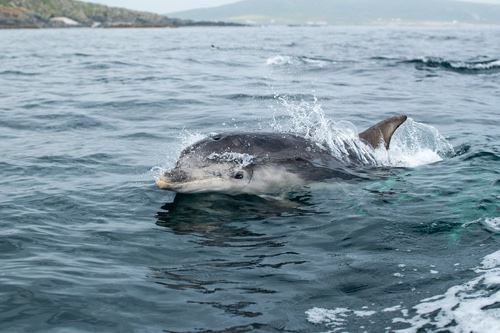ESS forces out open-net farmers’ use of acoustic deterrent devices

Environmental bodies protecting dolphins in Scotland have forced salmon farmers to change the way they protect their net pens.
Photo: Shutterstock/dutch_engels
The use of Acoustic Deterrent Devices (ADDs), which were being used on 90% of Scottish salmon farms in 2019 to scare away seals, has been successfully challenged by Environmental Standards Scotland (ESS), the new independent body set up to ensure the effectiveness of environmental law, and prevent enforcement gaps arising from the UK leaving the European Union,.
ADDs use underwater sound-waves to creates a ‘sound fence’ around a salmon farm by using random frequency sweeps and tones to unsettle approaching animals or produce sound at specific frequencies and volumes to cause discomfort to an approaching seal.
However, the devices can also disturb dolphins and porpoises, which are designated as European Protected Species (EPS) and protected under the Natural Habitats Conservation Regulations of 1994. Under such regulations, an ADD which disturbs protected species can only be used if the operator has obtained an EPS licence. To date, no EPS licences have been granted for any Scottish farms.
In November 2021, ESS received a representation from Guy Linley-Adams, the solicitor acting for The Coastal Communities Network (CCN), regarding Marine Scotland’s duty to ensure that the aquaculture industry complies with the Habitats Regulations.
The representation expressed concerns that fish farm operators had been using ADDs without a licence, and queried the sufficiency of Marine Scotland’s investigation and enforcement actions to stop such practices.
As a result, ESS scrutinised Marine Scotland’s compliance processes and sought supporting information from them to assess their fitness, specifically whether they were sufficiently robust enough to protect EPS in line with the requirements of the Habitats Regulations.
ESS made recommendations for improvements to Marine Scotland’s compliance process, which were implemented by Marine Scotland.
It also requested that Marine Scotland release public updates on the progress of their compliance works, to which they agreed.
ESS now considers that an “informal resolution has been achieved, as Marine Scotland have taken reasonable corrective actions in response to our comments and we have, at present, no ongoing concerns about Marine Scotland’s proposed approach to compliance”.
The Coastal Communities Network (CCN), which campaigned against ADD use over a long time, stated in a press release that it “is delighted with the case report from ESS, which is believed to be the first report of its kind from the new body”.
David Ainsley, from Sealife Adventures and a supporter of CCN, said: “This is a great result. Harbour porpoises and dolphins will enjoy greater protection as a result. Any salmon farmers who try to use ADDs must now expect enforcement action against them. CCN members will be watching – and indeed listening – for any law-breaking and we encourage the general public, and any fish-farm employees, to report any use of ADDs at once.”
Since the representation was made to ESS, Marine Scotland has introduced more inspections and has moved away from allowing the industry to self-regulating its use of ADDs. Most importantly the referral to the ESS has meant that fish farmers, if they use an ADD anywhere in Scotland, either need to apply and receive an EPS licence under the Habitats Regulations or they need to prove that a licence is not required.
“No use whatsoever”
It means that salmon farmers cannot now simply use ADDs and wait for Marine Scotland to challenge them because, following the EES intervention, using an ADD without either applying for a licence or proving that a licence is not required, will result now in enforcement action from Marine Scotland. To date, no fish farmer has either applied for a licence or proved that a licence is not required.
Guy Linley-Adams, solicitor to CCN, said, “At today’s date, there should be no use whatsoever of ADDs on salmon farms in Scotland.
“We also consider that it will be impossible for fish farmers to prove that ADD use will not damage or harm cetaceans. Further, it is impossible for Scottish Government to issue ADD licences under the Habitats Regulations, because there are many satisfactory alternatives to ADDs.
“To that end, we have achieved a de facto ban on the use of acoustic deterrent devices in salmon farming.
“We would like to thank the ESS. Their staff deserve very great credit for the speed with which they have dealt with this matter and for delivering an effective outcome in their first resolution of an environmental issue brought to them since they were established. This augurs well for Scotland.”
Salmon Scotland, which represents Scottish salmon farming, states on its website that” The Scottish salmon farming sector no longer uses acoustic deterrent devices (ADDs) that may have been considered to cause disturbance to European Protected Species.
“The only circumstances in which Scottish salmon producers will use ADDs in future is where ADDs comply with both Marine Scotland and US MMPA requirements and operators have been provided with evidence from suppliers of the devices’ compliance”.



